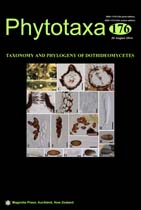Abstract
The family Elsinoaceae is a relatively poorly known, but important family within Myriangiales, Dothideomycetes. The genera of this family are mostly plant pathogens and causes disease, such as apple and grape scab. In this paper we revisit the family by examining generic types and analysis of molecular sequence data available in GenBank. Elsinoaceae and Myriangeaceae are morphologically and phylogenetically well-supported families in Myriangiales. In Elsinoaceae, 3 to 10 asci form in locules in light coloured pseudoascostromata, which form typical scab-like blemishes on leaf or fruit surfaces, while Myriangeaceae forms raised, superficial, black ascostromata with single asci in each locule, genera may or may not form scab-like lesions. Elsinoe is the type of the family Elsinoaceae and is characterized by forming scab-like blemishes on leaves with few to numerous bitunicate, fissitunicate, globose asci forming inside each locule with a pseudoascostroma containing fungal and host tissues. Following examination of generic type material, Molleriella is retained in Elsinoaceae as it has characters similar to Elsinoe in forming scab-like lesions with pseudoascostromata containing few to numerous bitunicate asci inside each locule. Beelia, Butleria, Hemimyriangium, Hyalotheles, Micularia, Saccardinula, Stephanatheca and Xenodium are excluded from Elsinoaceae and their relative placement in Dothideomycetes is discussed. Fresh collections of these genera are needed so that molecular sequence data can be obtained and analysed to resolve their placement in families or orders of Dothidoemycetes.

